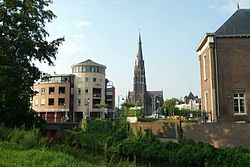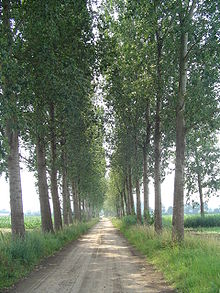Veghel
 flag |
 coat of arms |
| province |
|
| local community |
|
|
Area - land - water |
78.92 km 2 78.15 km 2 0.77 km 2 |
| Residents | 26,380 (June 30, 2017) |
| Coordinates | 51 ° 37 ' N , 5 ° 32' E |
| Important traffic route |
|
| prefix | 0413 |
| Postcodes | 2201, 5042, 5384, 5406, 5461-5462 |
| The Aa with the St. Lambertus in the background | |
Veghel ( ) is a former municipality in the northeast of the province of Noord-Brabant in the Netherlands . On January 1, 2017, Veghel was incorporated into the municipality of Meierijstad . Veghel is located in the Meierij van s-Hertogenbosch , an area near Herzogenbusch (Dutch: s-Hertogenbosch, colloquially Den Bosch ) about 20 km southeast of this city and about 25 km northeast of Eindhoven . On June 30, 2017, there were 26,380 residents who were at least 15 years old. Veghel is traversed by the river Aa . Veghel is also connected to the European waterway network by the Zuid-Willemsvaart Canal . In 1971 Veghel was twinned with the German city of Goch .
history
Archaeological finds in the Havelt peasantry date the first settlement in Veghel to the 6th century. Other finds come from Eerde and the 't Ven area. Remnants of these settlements have been found in the form of coins and Gallo-Roman urns along the Aa. In the early Middle Ages , Veghel belonged to the County of Rode ( Sint-Oedenrode ). In the 13th century Veghel was incorporated into the Duchy of Brabant as part of the Meierij von Herzogenbusch . Veghel is first mentioned in a document as Vehchele in 1225 . Veghel has been officially a parish since 1310 . In that year, Duke John II of Brabant gave the residents the right to use parish land. The usufruct of the community was given to the Lords of Erp. They lived in Frisselsteijn Castle in Veghel.
From 1648 Veghel was part of the Republic of the Seven United Netherlands . After the area in which Veghel is located became a military buffer zone for Holland in the Peace of Munster , Veghel suffered, like other areas of the generational states in the State Duchy of Brabant and State Limburg , under religious and economic oppression by Protestant Holland. The practice of Catholic worship was banned and the old St. Lambertus Church was given to a small number of Protestant officials . In 1649 the population of Veghel built a so-called barn church ( schuurkerk ) just beyond the state border in the Uden district , which at the time was not part of Brabant, but belonged to the free land of the Ravenstein rule . This was subject to the Palatinate-Neuburg family . Until the French invasion of 1672, the church was used not only by parishioners from Veghel, but also by Catholics from Schijndel and Sint-Oedenrode . In 1672 permission was given to build a new barn church in Veghel itself. This was located where the St. Lambertus Church is today. The lords of Frisselsteijn Castle left the necessary building site to the Catholic community. It was not until 1795, after the French invasion, that Veghel was given back his freedoms and finally became an equal member of the Kingdom of the Netherlands .
As a result of the construction of the Zuid-Willemsvaart canal, Veghel developed from a rural village to an industrial site in the second half of the 19th century. In the same period, the construction of the most important large buildings began, such as the neo-Gothic church of St. Lambertus, the old town hall and the Franciscan convent . With the establishment of a pedagogical college for primary school teachers in 1872, Veghel has one of the oldest institutions of its kind in the region.
Industry and trade flourished in the 1860s. After the village was connected to the canal by means of a one kilometer long harbor in 1825, flax cultivation in particular took off . Flax was grown in almost every family. In addition, there was intensive trade in butter as well as fattening calves and other cattle. Because of this commercial activity the residents Veghels received towards the end of the 19th century the nickname kuus (about the meaning of this word see below). In the middle of the 20th century, several international companies settled in Veghel. This generated growth , especially in the area of transport and logistics . Towards the end of the 20th century, the municipality devised the motto “Veghel Voedingstad” (Veghel Food City); this refers to the large number of local food and feed companies.
During the First World War Veghel served as a refuge for refugees from Belgium . Most of these were housed in church buildings.
In May 1940 Veghel was occupied by troops of the German Wehrmacht . As part of Operation Market Garden in September 1944, General Eisenhower and Field Marshal Montgomery and the paratroopers of the 2nd and 3rd Battalions of the 501st Parachute Infantry Regiment of the 101st Airborne Division occupied the area around Eerde, south of Veghel, and the area north of Veghel assigned as a landing site. They were given the task of conquering the so-called corridor, which ran precisely through Veghel, and keeping it open in order to enable the 30th British Army Corps to advance towards Nijmegen . In the corridor in Veghel were the strategically important bridges over the canal Zuid-Willemsvaart and the Aa, as well as two railway bridges of the Boxteler Bahn ( Duits Lijntje ).
In the further course of the fighting, there was heavy fighting and destruction in and around Veghel. German troops attempted to retake Veghel from the direction of Schijndel via the Boxteler Bahn and to regain control of the bridges over the Zuid-Willemsvaart canal. This led to heavy fighting in the corridor between Veghel and Eerde. On September 26, 1944, the fighting in and around Veghel was decided in favor of the Allies, whereupon the American Colonel Johnson set up his headquarters in the center of Veghel. The building was then named Klondike. A gable stone with the badge of the 101st Airborne Division on this building reminds of this.
On January 1, 2017, Veghel merged with the municipalities of Schijndel and Sint-Oedenrode to form the new municipality of Meierijstad.
Administrative division
The former municipality of Veghel consisted of two cadastral residential areas: the Veghel residential area from a medium- sized town (Veghel) with three neighboring villages (Eerde, Mariaheide, Zijtaart) and Erp from a small country town (Erp) and two small villages (Boerdonk, Keldonk). The Dutch statistics agency , according to these consist of:
Living spaces
Population of the residential places:
| Veghel | 31,032 |
| Erp | 6,743 |
Source: CBS , 2015
Closed localities
Population of the built-up areas:
| Veghel | 26,491 | |
| Erp | 4,761 | |
| Mariaheide | 1,449 | |
| Zijtaart | 1,727 | |
| Eerde | 1,365 | |
| Keldonk | 1,204 | |
| Boerdonk | 778 |
Source: CBS , 2015
hamlet
The following hamlets belonged to the whole community Veghel: Dorshout , Havelte, Doornhoek, Ham, Kempkens, Lagebiezen, Hogebiezen, Dijk, Ven, Driehuizen, Hazelberg, Bolst, De Laren, Dieperskant, bus, Hurkske, Beukelaar, Heuvel, Heuvelberg, Oudveld , Willebrordushoek en Zondveld , Kraanmeer, Looieind, Morse Hoef, Hoek
Industrial location
Industrial areas
- Dorshout
- De Dubbelen
- De Amert
- Doornhoek
media
- Brabants Dagblad : Regional newspaper, published since 1770; Local section for Veghel and Uden.
- Stadskrant Veghel: oldest local weekly newspaper of its kind in the region.
- Veghels Nieuwsblad: local weekly newspaper.
- Omroep Brabant: regional television station with radio and television studios in Son en Breugel - Eindhoven .
- Skyline-Radio-TV: local TV station with broadcasting studio in the former fire station in Uden.
- StadsTV11: local cable TV .
- Kliknieuws: version of StadsTV11 published on the Internet.
Events
- In November, the entry of Sinterklaas (Saint Nicholas) into the port of Veghel takes place.
- The harbor festival takes place at the beginning of September.
- In mid-September, the Aado classic car club organizes a classic car rally with departure and arrival in Veghel.
- In February / March the traditional carnival is celebrated in Veghel , whereby Veghel changes into the Kuussegat (gat = hole, gap). Although in large parts of Brabant and Limburg the word kuus (j) means pig in the dialect, the symbol of the Veghel carnival is a calf, as Veghel was known for its calf market in the 19th and early 20th centuries. On Carnival Saturday there is a parade by and for children, while on Carnival Sunday there is a large carnival parade with contributions from associations and private individuals from all over the area.
- The highlight of the carnival week is the annual voodle festival , which is organized jointly by Veghel and Uden.
- In mid / end of May, the hardcore techno festival "Harmony of Hardcore" (30,000+ visitors) takes place in Erp over a weekend.
Attractions
- Neo-Gothic St. Lambertus Church , an important early work by the architect Petrus Josephus Hubertus Cuypers with Calvary and war graves .
- Former town hall in neo -renaissance style .
- Former neo-Gothic synagogue .
- Protestant Waterstaatkerk
- Convent of the Franciscan Sisters of the convent garden and Chapel.
- Leisure harbor
- Monument to the 101st Airborne Division
Personalities
- Marcel van de Beeten (born May 2, 1959), jazz guitarist and singer-songwriter
- Frits van Eerd (born March 25, 1967), entrepreneur and racing car driver
- Rein van Duijnhoven (born September 5, 1967), football goalkeeper
- Rob Jetten (born March 25, 1987), politician
- Theo Lucius (born December 19, 1976), football player
- Ton Smits (born February 18, 1921 - † August 5, 1981 in Eindhoven), cartoonist
- Earnie Stewart (born March 28, 1969), football player
Web links
- Dutch website with information for residents and visitors of Veghel ( Memento of September 8, 2008 in the Internet Archive )
Individual evidence
- ↑ a b Personen met een uitkering; soort uitkering, wijken en buurten 2017 Centraal Bureau voor de Statistiek , accessed on March 30, 2018 (Dutch)
- ^ A b Population per center as of 01-01-2015 , Municipality of Veghel. January 1, 2015. Accessed April 24, 2015.
- ↑ Home - Harmony of Hardcore. Retrieved May 21, 2018 (American English).





